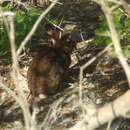en
names in breadcrumbs


Perception Channels: tactile ; chemical
Sylvilagus graysoni flourished throughout the Tres Marias Islands at the beginning of the century, but in the last survey of this species (1976) it was shown that its population has significantly dropped. In the last 10 years, the number of Sylvilagus graysoni has been reduced by 50 percent. This trend is anticipated to continue.
This species has evolved in an environment that is relatively predator-free, and therefore it is not prone to run away if approached by humans. Hunters kill these rabbits with minimal difficulty. Other threats to its survival include modification of its habitat by clearing of vegetation, newly introduced species such as pigs and goats, and human settlements.
Surveys have been recommended to determine the present status of the species. Research is being initiated with hopes of preserving the remainder of the species. (Cervantes, 1997; Hoffman, 1993)
US Federal List: no special status
CITES: no special status
IUCN Red List of Threatened Species: endangered
There is no evidence of Tres Marias cottontails adversely affecting humans. There is documentation of other species of cottontail rabbits damaging crops, forest plantations, and shrubs.
(Nowak 1999; Schneider, 1990)
Tres Marias cottontails are hunted by humans. They benefit humans by providing game for hunters and valuable furs. (Cervantes, 1997; Nowak, 1999)
Positive Impacts: food ; body parts are source of valuable material
Tres Marias cottontails feed on a wide variety of plant material and herbaceous species. Their diet consists of bark and twigs during the colder months of the year.
This species, like other rabbits, excrete two kinds of fecal matter. The soft, green pellets are reingested in order to absorb vitamin B that can only be extracted after food is digested once. (Nowak, 1999; Schneider, 1990)
Primary Diet: herbivore (Folivore , Lignivore)
Sylvilagus graysoni is restricted to the Tres Marias Islands, 100 km west of the coast of Mexico.(Nowak, 1999)
Biogeographic Regions: nearctic (Native )
Other Geographic Terms: island endemic
The habitat of Sylvilagus graysoni consists of dense vegetation, including trees and bushes. This species thrives in areas that provide cover, and does not prefer to be in open fields.
These rabbits seek shelter in burrows made by other animals, under piles of brush, or within the vegetation. (Schneider, 1990)
Terrestrial Biomes: savanna or grassland ; forest ; scrub forest
The Tres Marias cottontail is a medium to large-sized rabbit, with gray, brown, and red fur. Its underside is generally pale brownish-red, and the species is characterized by a brown patch of fur on its throat. Its tail is brown above and white below. These rabbits do not turn white during the winter.
The average head and body length ranges from 215-471 millimeters, while tail length varies from 15-60 millimeters. Compared to other species of cottontails, Sylvilagus graysoni has relatively short ears that are approximately 57 millimeters long. The average length of the rabbit's hind foot is 95 millimeters.
Females in the species have four or five pairs of mammae. There are no significant sexual dimorphism except that adult females tend to be slightly larger than adult males. (Cervantes, 1997; Schneider, 1990)
Range mass: 0.24 to 2.7 kg.
Average mass: 1.47 kg.
Other Physical Features: endothermic ; bilateral symmetry
There is very little information on the reproduction of this species. The gestation period, number of young per birth, and number of litters per lifetime are unknown.
There is no mention of when in the year births are most likely to occur, the degree of development of the neonate, or the weight and length of the newborn rabbit.
There is no information regarding the estrous cycle of females, or of the mating systems of Tres Marias cottontails. (Cervantes, 1997; Nowak, 1999; Schneider, 1990)
Key Reproductive Features: gonochoric/gonochoristic/dioecious (sexes separate); sexual
Parental Investment: altricial
The Tres Marias cottontail or Tres Marias rabbit (Sylvilagus graysoni) is a species of mammal in the family Leporidae.[1]
It is endemic to the Tres Marias Islands, part of the Mexican state of Nayarit.[2] The rabbit is abundantly found in both the Madre and Magdalena islands but only has some occurrences in the Cleofa island.[3] Its natural habitat is subtropical or tropical dry forests.
It is threatened by habitat loss.
The rabbit only has three predators - the Tres Marias raccoon (Procyon lotor insularis), a subspecies of the common raccoon, and two birds of prey: the red-tailed hawk (Buteo jamaicensis) and the crested caracara (Caracara plancus).[3]
The Tres Marias cottontail or Tres Marias rabbit (Sylvilagus graysoni) is a species of mammal in the family Leporidae.